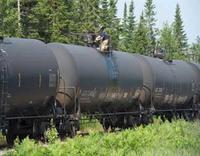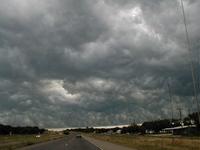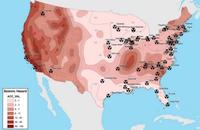-
Public-private partnership proposed to fund Calif. seismic early warning system
California state agencies federal agencies, are proposing a partnership between public and private agencies to build the $23.1 million earthquake early warning system in the state, and fund the $11.4 million annual operating budget. Governor Jerry Brown signed Senate Bill 135 in 2013 authorizing construction of the warning system, but the bill does not provide or allocate funding, despite a plan to have the system active in two years. The early warning system will provide Los Angeles residents up to a minute’s notice if a large earthquake is generated on the San Andreas Fault in the Salton Sea area. The system could also provide warnings for earthquakes that occur throughout California’s earthquake-prone landscape.
-
-
The next Bay Area’s Big One may be a cluster of major quakes
A cluster of closely timed earthquakes over 100 years in the seventeenth and eighteenth centuries released as much accumulated stress on San Francisco Bay Area’s major faults as the Great 1906 San Francisco earthquake, suggesting two possible scenarios for the next “Big One” for the region, according to new research. “The plates are moving,” the study’s co-author said. “The stress is re-accumulating, and all of these faults have to catch up. How are they going to catch up?”
-
-
Pumping Central Valley’s ground water increases number of California’s earthquakes
Scientists have offered a new theory explaining the steady increase in the number of small earthquakes in parts of Central California. They say that the quakes are partly due to the pumping of groundwater. Groundwater is heavy, and depresses the Earth’s upper crust like a weight. Without that weight, the earth springs upward and the change in pressure can trigger more small earthquakes.
-
-
U.S. to require railroads to notify states when oil is shipped

With the increase in available oil from fracking and larger pipeline capacity, railways are moving more and more oil. Rail companies moved 400,000 oil carloads in 2013, dwarfing 2005’s 6,000 oil carloads. The increase in oil shipments of oil has led to an increase in the number of accidents involving oil tankers. In the wake of recent accidents, the U.S. Department of Transportation (DOT) has released an emergency order to railroad companies which is designed to reduce the risk when shipping crude oil across the nation.
-
-
Texas cities adopt 911 texting

Adding to the rising number of U.S. cities that accept 911 emergency texts, North Texas public safety agencies will now institute the procedure at their response centers. 911 emergency texting not only helps the deaf, but it better caters to younger generations that do not recognize as much the divide between text and voice communications. The texting of additional media such as photos before the responders reach the site could also have a profound impact on the development of an emergency situation.
-
-
April storms lead to first billion-dollar losses of 2014

The outbreak of severe weather throughout the United States and other parts of the world in April will prove to have caused the largest economic losses since 2013, according to a report. During the month in the United States, at least 39 people were killed and 250 injured amid nearly 70 confirmed tornado touchdowns, which occurred across more than 20 states in the Plains, Mississippi Valley, Southeast, Midwest, and Mid-Atlantic.
-
-
Colorado tries to increase safety of urban development in wildfire-prone areas
Colorado continues to deal with the challenge of building new urban developments while reducing wildfire risks. There are currently 556,000 houses built in burn zones around the state, and the demand for water to sustain residents and industries continue to rise. A new study predicts that development will occupy 2.1 million acres in wildfire-prone forests by 2030, an increase from one million acres today — just as wildfires continue to burn roughly 900,000 acres a year since 2000, compared with just 200,000 acres a year in the 1990s.
-
-
Improving gloves to enhance first responders’ safety
Firefighters wear protective gloves called “structure gloves” to keep their hands safe on the job. The structure gloves currently used by firefighters, however, are not designed for the precision movements first responders must perform. There are many different types of structure gloves available, but none fully satisfies modern firefighters’ needs. Today’s compact tools often have small buttons that require nimble movements. Bulky gloves can make it difficult for firefighters to complete simple tasks without removing their gloves and compromising their safety. As advanced textile technology and materials continue to develop, the science behind firefighter structure gloves has adapted.
-
-
Limiting methane emissions would more quickly affect climate than limiting CO2
When discussing climate change, scientists point to “radiative forcing,” a measure of trapped heat in Earth’s atmosphere from man-made greenhouse gases. The current role of methane looms large, they say, contributing over 40 percent of current radiative forcing from all greenhouse gases. The role of methane as a driver of global warming is even more critical than this 40 percent value might indicate, they note, since the climate system responds much more quickly to reducing methane than to reducing carbon dioxide. The implication is that while it is true that in order to slow, or even reverse, global warming we must limit emissions of both carbon dioxide and methane, it makes more sense to concentrate now on limiting methane emissions because reducing methane emissions would buy society some critical decades of lower temperatures.
-
-
Fire experiments will test new firefighting tactics
Fire researchers at the National Institute of Standards and Technology (NIST) will return to Spartanburg, South Carolina, on 15-21 May 2014, as part of a collaborative effort on a series of controlled-burn experiments in detached single-family homes slated for demolition. Measurements of temperature, total heat flux and other ground truth data gathered during the live fire experiments will help the NIST team and its partners to further assess the effectiveness of new fire-suppression tactics known as transitional fire attack.
-
-
Coral reefs offer valuable protection for coastal infrastructure
Growing natural hazards from coastal storms, flooding, and rising sea levels are leading to major investments worldwide in coastal defense structures such as seawalls and breakwaters. A new study shows that coral reefs can provide risk reduction benefits comparable to artificial defenses, and reef restoration and enhancement is a cost-effective alternative to manmade structures. Restoring coral reefs as a way to protect coastal infrastructure is also cheaper: the typical price for a tropical breakwater project is $197 million, compared with $129 million for restoring a reef.
-
-
24 U.S. nuclear plants vulnerable to earthquakes

The U.S Nuclear Regulatory Commission (NRC) has concluded that the designs of twenty-four U.S. nuclear plants do not meet contemporary standards to withstand an earthquake in the vicinity of the facility. This analysis has revealed that these facilities could face significant, even disastrous, damage from earthquakes which are larger than what they were designed to encounter.
-
-
Loss of West Antarctic glacier unstoppable, contributing significantly to sea level rise
A rapidly melting section of the West Antarctic Ice Sheet appears to be in irreversible decline, with nothing to stop the entire glacial basin from disappearing into the sea, according to researchers at UC Irvine and NASA. The new study presents multiple lines of evidence — incorporating forty years of observations — that six massive glaciers in the Amundsen Sea sector “have passed the point of no return.” The volume of melted ice would be enough to raise global sea level by four feet.
-
-
Industry, Democrats reject GOP-sponsored TRIA-extension draft
House democrats and members of Property Casualty Insurers, a leading insurance trade group, have rejected a Republican-sponsored draft proposal which would alter some measures of the current Terrorism Risk Insurance Act (TRIA). The Property Casualty Insurers did not mince words, calling the GOP plan “unworkable for the marketplace.” The proposal would raise the amount of damage caused by a terrorist attack from the current $100 million to $500 million before government coverage is triggered (the higher threshold would apply to attacks which do not involve nuclear, biological, chemical, or radiological means).
-
-
Teleoperated robots for smarter disaster response

Electrical engineers have developed telerobotics technology which could make disaster response faster and more efficient. The researchers aim to combine existing “smart” technologies better to serve society during disaster and crisis response. This includes using teleoperated robots for rescues and safety operations; a high-tech dispatch system that gathers information from cameras and sensors and pushes it out to first responders; drones for damage surveillance and rescues; and vests outfitted with sensors and GPS tracking to be worn by search-and-rescue dogs.
-
- All
- Regional
- Water
- Biometrics
- Borders/Immig
- Business
- Cybersecurity
- Detection
- Disasters
- Government
- Infrastructure
- International
- Public health
- Public Safety
- Communication interoperabillity
- Emergency services
- Emergency medical services
- Fire
- First response
- IEDs
- Law Enforcement
- Law Enforcement Technology
- Military technology
- Nonlethal weapons
- Nuclear weapons
- Personal protection equipment
- Police
- Notification /alert systems
- Situational awareness
- Weapons systems
- Sci-Tech
- Sector Reports
- Surveillance
- Transportation
Advertising & Marketing: advertise@newswirepubs.com
Editorial: editor@newswirepubs.com
General: info@newswirepubs.com
2010-2011 © News Wire Publications, LLC News Wire Publications, LLC
220 Old Country Road | Suite 200 | Mineola | New York | 11501
Permissions and Policies
Editorial: editor@newswirepubs.com
General: info@newswirepubs.com
2010-2011 © News Wire Publications, LLC News Wire Publications, LLC
220 Old Country Road | Suite 200 | Mineola | New York | 11501
Permissions and Policies
